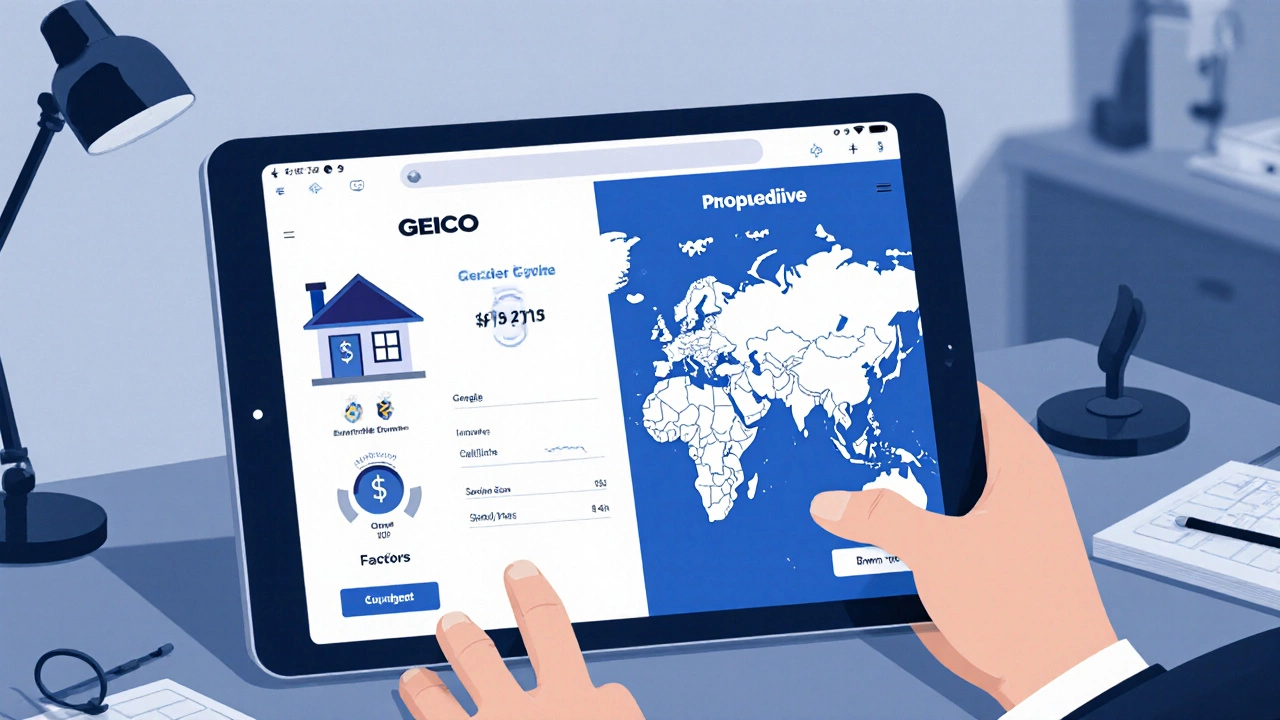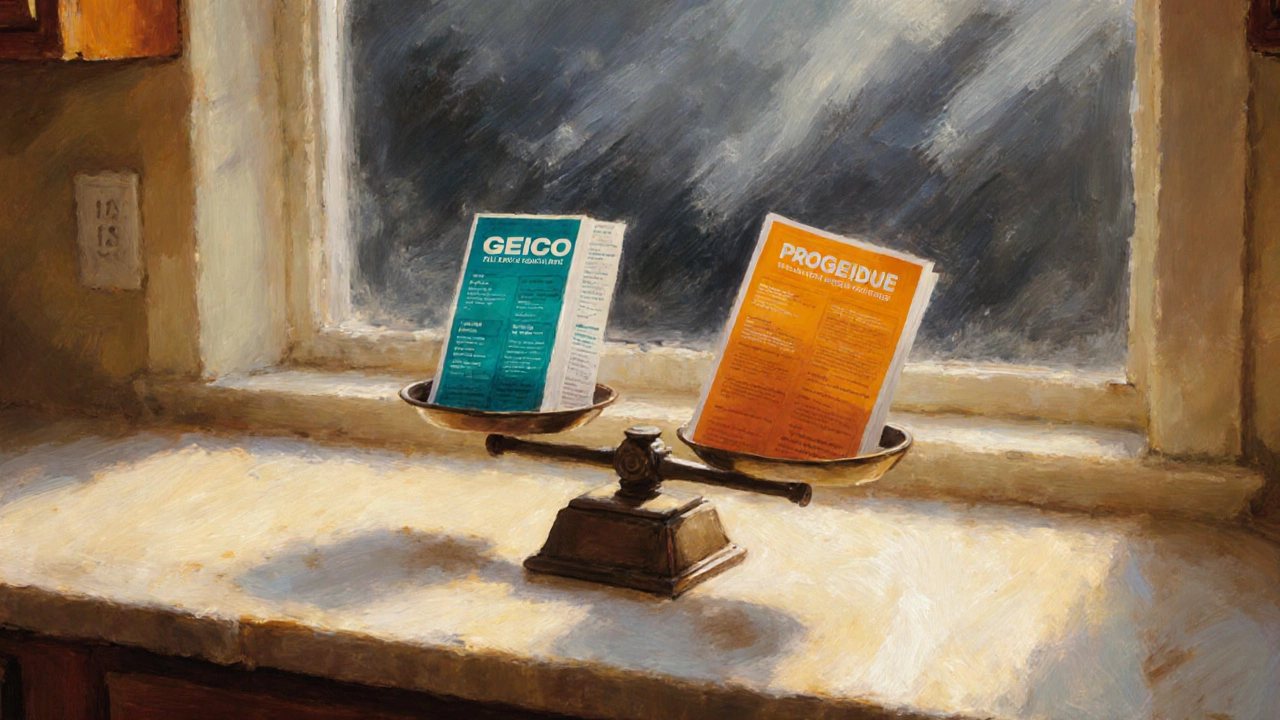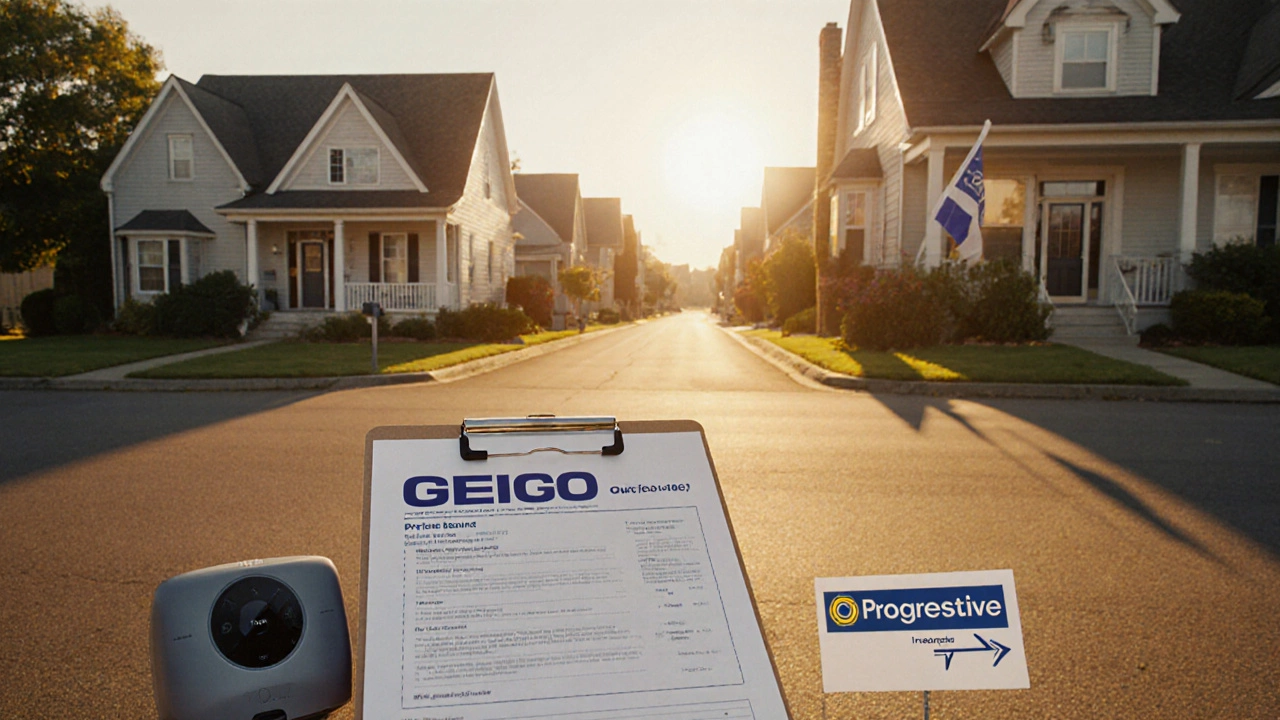Trying to figure out whether Geico or Progressive will give you the lowest home‑insurance price can feel like a guessing game. Both companies are big players in the U.S. market, but they price policies very differently based on a mix of personal data, location, and discount tricks. Below you’ll get a clear breakdown of how each carrier builds its premium, real‑world 2025 price snapshots, and a side‑by‑side table that lets you spot the cheaper option in seconds.
Key Takeaways
- Geico usually wins on basic liability and bundled discounts, especially for renters and first‑time homeowners.
- Progressive tends to be cheaper for high‑coverage limits and homes located in states with severe weather exposure.
- Both insurers factor the same core drivers-home value, construction type, claim history-but they weight them differently.
- Getting an accurate quote from each company is the only way to know which one is truly cheaper for you.
- Use the comparison table to match your personal risk profile with the carrier that offers the best price‑to‑coverage ratio.
How Geico Calculates Home‑Insurance Premiums
Geico entered the home‑insurance market in 2021 and relies heavily on its auto‑insurance data. The company pulls three main data streams:
- Property value - assessed by the insurer’s own valuation tool, which uses square footage, rebuild cost, and local labor rates.
- Risk score - derived from credit‑based insurance scores, neighborhood crime rates, and proximity to fire stations.
- Discount stack - Geico loves bundling. A multi‑policy holder can grab up to 25% off the base premium.
Geico also offers a “Pay‑What‑You‑Drive” style discount for homeowners who install smart‑home devices, but the impact on home coverage is modest (usually 5‑7%). The final premium is the sum of the base rate, risk surcharge, and any optional endorsements (like flood or earthquake).
How Progressive Calculates Home‑Insurance Premiums
Progressive’s pricing engine was built to handle more variable coverage needs, so it looks at a broader set of factors:
- Construction type - wood frames get a higher surcharge than steel or concrete.
- Coverage depth - Progressive lets you pick the exact dwelling coverage, and the price scales linearly.
- Weather‑zone rating - Homes in high‑wind, flood, or wildfire zones receive a weather‑risk multiplier.
Progressive also offers an “Name‑Your‑Price” tool that lets you set a maximum monthly budget; the algorithm then trims optional coverages to fit that budget. In 2025, the average discount for bundling auto and home policies sits at 18%, a bit lower than Geico’s but still meaningful.
Core Factors That Influence Both Quotes
Even though Geico and Progressive weigh them differently, the following variables appear on every home‑insurance estimate:
- Replacement cost - how much it would cost to rebuild the house from scratch.
- Location - ZIP code, crime statistics, proximity to fire hydrants.
- Age of the home - older homes often need higher liability coverage for outdated wiring.
- Claims history - more than two claims in the past five years raises the premium by 10‑15%.
- Credit‑based insurance score - a higher score can shave 5‑12% off the base rate.
Understanding how each carrier interprets these data points helps you anticipate where the price gap will appear.

Real‑World 2025 Price Snapshots
Below are three typical scenarios pulled from quotes generated in August 2025. Numbers are average monthly premiums before taxes.
- Scenario A - Single‑family home, 2,200 sq ft, built 2005, located in Columbus, OH. Geico: $91/month. Progressive: $84/month.
- Scenario B - Townhouse, 1,400 sq ft, built 1990, located in Austin, TX (high wind zone). Geico: $112/month. Progressive: $97/month.
- Scenario C - Condo, 950 sq ft, built 2018, located in Detroit, MI. Geico: $78/month (after bundling auto). Progressive: $81/month (after bundling).
Notice how Progressive wins on the higher‑risk scenarios (B) while Geico edges out on lower‑risk, bundled cases (C).
Side‑by‑Side Comparison Table
| Feature | Geico | Progressive |
|---|---|---|
| Base premium (average) | $95/month | $98/month |
| Maximum bundle discount | 25% | 18% |
| Best for high‑coverage limits | No | Yes |
| Best for low‑risk homes | Yes | Mixed |
| Smart‑home discount | 5‑7% | 4‑6% |
| Customer satisfaction (J.D. Power 2024) | 4.1/5 | 4.0/5 |
| A.M. Best financial strength | A+ | A |
How to Get an Accurate Quote from Each Insurer
Both companies let you start the process online, but a few extra steps can prevent under‑estimation:
- Gather your latest home appraisal or a detailed replacement‑cost estimate.
- List every optional coverage you want (flood, earthquake, personal‑property).
- Enter the exact square footage, roof type, and age of major systems (HVAC, plumbing).
- Ask about discounts you qualify for: multi‑policy, claim‑free, senior, or smart‑home device.
- Request a “hard” quote (rather than a soft estimate) so the insurer runs a full underwriting check.
Hard quotes often differ by $5‑$15 per month from the quick online estimate, especially in coastal states.
Tips to Lower Your Home‑Insurance Cost
- Bundle with auto - both Geico and Progressive reward you with a sizable discount.
- Increase your deductible - raising it from $500 to $1,000 can cut the premium by up to 12%.
- Upgrade security - smart locks, motion sensors, and fire‑suppressant systems shave a few percent off the rate.
- Maintain a clean claims history - avoid filing small claims; they add a surcharge on the next renewal.
- Shop annually - insurers refresh their underwriting models each year, so a better deal may appear even if you’re satisfied.

When Geico Is Likely Cheaper
If your home sits in a low‑risk zip code, you already have an auto policy with Geico, and you qualify for at least two of the available discounts, Geico’s bundled approach usually wins. The company’s pricing engine also leans on credit scores, so a strong credit profile amplifies the discount.
When Progressive May Beat Geico
If you need high dwelling coverage (e.g., a luxury remodel) or you live in a weather‑prone area, Progressive’s flexible coverage options and weather‑zone multiplier often produce a lower final cost. Their “Name‑Your‑Price” tool can also force the premium down if you’re comfortable trimming extra endorsements.
Bottom Line
The short answer to “who is cheaper?” is: it depends on your risk profile, coverage needs, and discount eligibility. For most low‑risk, multi‑policy households, Geico vs Progressive tips the scale toward Geico. For high‑coverage or high‑risk locations, Progressive’s customized pricing usually edges out. The safest move is to pull hard quotes from both, compare the numbers side by side, and then apply the discount checklist above.
Frequently Asked Questions
Does Geico offer flood insurance?
No. Geico partners with third‑party providers for flood coverage, so you’ll receive a separate policy endorsement and a distinct premium.
Can I get a discount for installing a home security system?
Both Geico and Progressive award a 5‑7% discount for verified smart‑home devices, including alarms, cameras, and smoke detectors.
Which insurer has a higher financial strength rating?
Geico holds an A+ rating from A.M. Best, while Progressive carries an A rating. Both are considered very strong, but Geico’s rating is marginally higher.
Is it worth switching if I already have a home policy?
Switching can save 5‑15% per year, especially if you can bundle a new auto policy. Run a side‑by‑side quote and factor in any surrender fees before deciding.
Do both companies handle claims the same way?
Geico uses a largely digital claims process with a 24/7 phone line; Progressive offers a similar digital portal but also provides a dedicated claims adjuster for larger losses. Response times are comparable, usually under 48 hours for initial contact.
